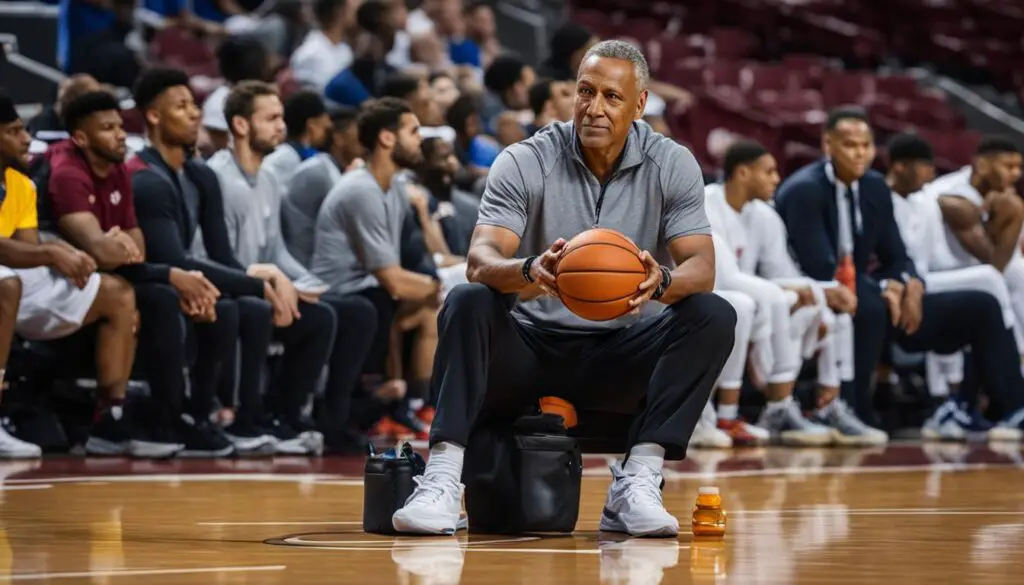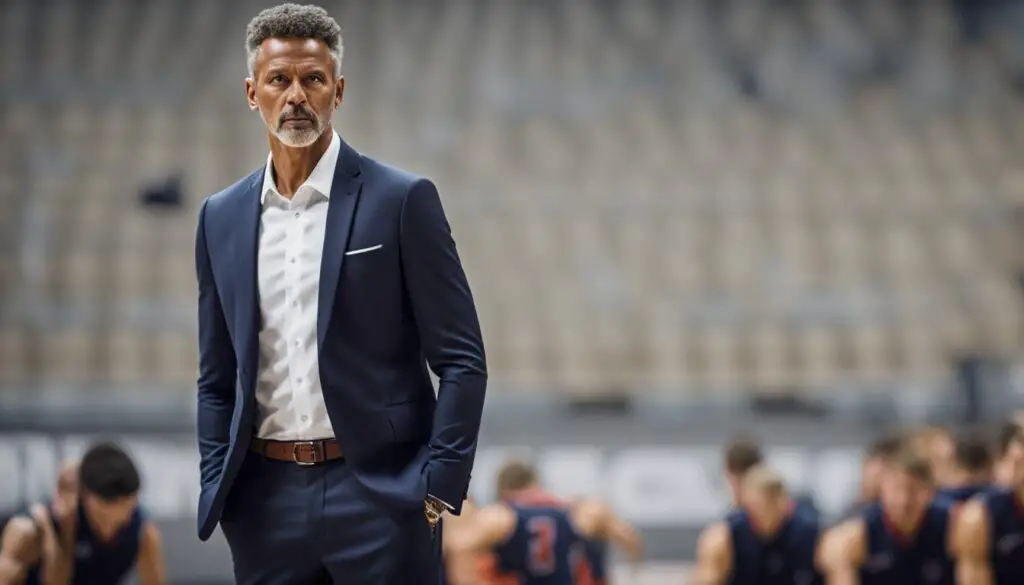In recent years, there has been a debate about whether basketball coaches should continue to wear suits and ties during games. The tradition of coaches donning this formal attire can be traced back to the NBA and college basketball, but the reasons behind it have evolved over time. Let’s explore the factors that have contributed to the adoption and continuation of this dress code.
Key Takeaways:
- The dress code for basketball coaches has shifted from formal suits and ties to more casual attire.
- The NBA and college basketball have influenced the traditional dress code for coaches.
- Coaches embrace casual attire for practicality, comfort, and convenience.
- There are concerns about how casual attire impacts professionalism and image.
- The future of coaching attire remains uncertain as individual preferences and trends come into play.
The Evolution of Basketball Coaching Attire
The dress code for basketball coaches has evolved significantly over the years, reflecting changes in basketball fashion and the overall casualization of attire in sports. Traditionally, coaches in the NBA were required to wear suits and ties, symbolizing the formal nature of the sport and projecting a professional image. However, in recent times, there has been a noticeable shift towards a more relaxed and casual dress code.
One notable milestone in this evolution was the NBA’s Orlando bubble during the COVID-19 pandemic. As teams played in a controlled environment without fans, the league implemented a more relaxed dress policy for coaches. This allowed them to wear team-issued polos and quarter-zips, providing a comfortable and practical alternative to formal attire.
This shift towards casual dress was not exclusive to the NBA. College basketball also followed suit, granting coaches the freedom to wear sweats and joggers instead of suits and ties. The pandemic accelerated this trend, with coaches prioritizing hygiene and comfort in their attire.
The pandemic’s impact on coaching attire was undeniable, as it forced a reconsideration of traditional dress codes. The practicality and convenience of casual attire became more apparent, especially with reduced dry cleaning expenses and the ease of travel. Comfort and the ability to engage with players on the court also became significant factors in the shift towards more relaxed attire.
While the casualization of coaching attire has its advantages, it raises questions about professionalism and the image coaches project. The traditional suit and tie conveyed a sense of respect for the game and reflected the high status of the NBA. Critics argue that the shift towards casual dress, particularly among older generation coaches, diminishes professionalism and the overall perception of the sport.
Looking ahead, the future of coaching attire remains uncertain. As the world recovers from the pandemic, there is speculation about whether coaches will continue to embrace the more casual dress or revert to the traditional suits and ties. Ultimately, the choice of attire will likely depend on individual coach preferences, the desire for comfort, and the image they wish to portray.
The Practicality and Comfort of Casual Attire
Many coaches have embraced the shift to more casual attire due to its practicality and comfort. The convenience of casual dress allows coaches to focus more on their coaching duties without the need to adhere to a strict formal dress code. Coaches like Monty Williams and Gregg Popovich have lauded this new dress code, emphasizing its convenience and reduced dry cleaning expenses.
By opting for casual attire, coaches can pack lighter for trips and avoid the hassle of lugging multiple bags. This ease of travel enables them to arrive at games and events feeling more refreshed and ready to focus on their players. Additionally, the comfort of casual attire allows coaches to move freely and engage with their players on the court, fostering better communication and teamwork.

The comfort and practicality of casual attire for coaches also aligns with athlete fashion trends. Coaches understand that the game is ultimately about the players, and their attire should reflect that perspective. By embracing casual dress, coaches can mirror the style and preferences of their athletes, creating a more inclusive and cohesive team environment. This acknowledgment of athlete fashion trends demonstrates coaches’ commitment to understanding and connecting with their players on and off the court.
The Impact on Professionalism and Image
While the shift to casual attire has its benefits, there are concerns about how it impacts the professionalism and image of coaches. The traditional suit and tie attire was seen as a reflection of the high status and attention given to the NBA. Coaches dressed to the nines not only showed their respect for the game but also conveyed the seriousness of their role in developing and managing a successful team. Some critics argue that the more casual attire adopted by coaches, especially in college basketball and among older generation coaches, detracts from the image of professionalism and diminishes the respect for the game.
It is undeniable that the way coaches dress contributes to the perception of professionalism in coaching. The attire a coach wears can reflect the status of the NBA as a premier basketball league and the respect they have for the game. The traditional suit and tie represented a sense of formality and a commitment to excellence.
However, as times change, so do fashion trends and cultural norms. The adoption of more casual attire by coaches, particularly seen in college basketball and among older generation coaches, has raised questions about the impact on professionalism. Critics argue that the shift to more relaxed dress diminishes the respect for the game and fails to uphold the standards set by the NBA.
While it is important to acknowledge the concerns raised by critics, it is also crucial to recognize that the perception of professionalism can vary among individuals and generations. Younger coaches may prioritize comfort and a more relatable image to connect with players and fans. Additionally, the NBA’s influence on the fashion industry cannot be ignored.
As LeBron James once said, “It’s about how you feel when you walk into the building, and it’s a part of the culture.”
The impact of coaching attire on professionalism and image is a topic of ongoing debate within the basketball community. There is a delicate balance between embracing modern trends and upholding the traditions of the game. Ultimately, coaches must find a dress code that aligns with their individual values and the perception they want to convey to players, fans, and the wider basketball community.
| Benefits of Casual Attire | Concerns about Professionalism |
|---|---|
| 1. Increased comfort for coaches. | 1. Perception of a lack of respect for the game. |
| 2. Cost savings on dry cleaning expenses. | 2. Diminished seriousness and commitment to excellence. |
| 3. Flexibility for travel and ease of movement on the court. | 3. Potential negative impact on the image of coaches and the NBA. |
The Future of Coaching Attire
As the pandemic subsides and a sense of normalcy returns to the world of basketball, there is speculation about the post-pandemic dress code for coaches. Will they continue to embrace the casual attire that emerged during the pandemic, or will there be a potential return to the traditional suits and ties?
The dress code for coaches is not set in stone, and there is no rule mandating a specific attire. Other sports, such as baseball and football, have more relaxed dress codes for coaches, allowing for flexibility in their wardrobe choices. However, the question remains: will basketball coaches prioritize comfort and convenience or opt for a more formal appearance to maintain professionalism?
During the pandemic, the shift to casual attire was driven by the need for comfort and hygiene, as well as the absence of fans in the arena. Coaches found that more relaxed clothing, such as polo shirts and quarter-zips, offered a balance between comfort and professionalism. This flexibility in the dress code allowed coaches to focus on their coaching duties without sacrificing their personal preferences for comfort.
On the other hand, the traditional suits and ties were seen as a symbol of professionalism and respect for the game. Wearing formal attire conveyed a sense of authority and seriousness in the role of coaching. Some argue that returning to this dress code would uphold the professional image of basketball coaches and reinforce the importance of their position.
Ultimately, the future of coaching attire will likely depend on individual coach preferences and the image they want to portray. Each coach may have their own unique style and approach to dressing for games. Some may choose to continue with the more casual attire, prioritizing comfort and flexibility. Others may opt for a return to suits and ties, believing it reflects a higher level of professionalism and dedication to the sport.
Whichever direction coaches choose, it is important to recognize that the attire should not overshadow their coaching abilities and the development of their players. The focus should always be on the game and guiding the team to success.

Conclusion
The shift in coaching attire from suits and ties to more casual options has sparked debates about professionalism and image in basketball. While the traditional attire conveyed a sense of respect and seriousness, the trend towards casual dress reflects the changing times and the desire for comfort and convenience.
The dress code for coaches is not static, and as the sport evolves, so does the attire. Whether coaches continue to embrace the casual dress or return to suits and ties, one thing is clear – the focus should ultimately be on their coaching abilities and the development of their players. The choice of attire should be a personal one,
balancing individual preferences with the perception of professionalism.
By finding the right balance between comfort and professionalism, coaches can confidently step onto the court, ready to guide their teams to victory. It is important to recognize that each coach may have unique preferences when it comes to their attire, and these preferences should be respected. As long as coaches maintain a level of professionalism and convey their dedication to the game, the specific clothing they choose to wear should not be the determining factor in their coaching abilities.
FAQ
Why do basketball coaches wear suits and ties?
The tradition of coaches wearing suits and ties in basketball can be traced back to the NBA and college basketball. It reflects the formal nature of the sport and conveys a sense of professionalism and respect for the game.
Has the dress code for basketball coaches changed over the years?
Yes, the dress code for basketball coaches has undergone significant changes. In recent years, there has been a shift towards more casual attire, particularly during the COVID-19 pandemic. Coaches have been allowed to wear team-issued polos, quarter-zips, sweats, and joggers.
What are the benefits of coaches wearing casual attire?
Coaches have embraced the shift to casual attire due to its practicality and comfort. It allows for more convenience in packing, reduces dry cleaning expenses, and enables coaches to move freely and engage with players on the court.
How does casual attire impact the professionalism and image of coaches?
Some critics argue that the adoption of casual attire by coaches, especially in college basketball and among older generation coaches, diminishes the image of professionalism and respect for the game. The traditional suit and tie attire was seen as reflection of the high status of the NBA.
What is the future of coaching attire?
As the pandemic subsides and a sense of normalcy returns, it remains to be seen whether coaches will continue to embrace casual attire or revert to suits and ties. The dress code for coaches is not set in stone, and the choice may come down to individual coach preferences and the image they want to portray.
